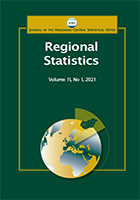Employment data of participants in supported adult training for jobseekers and their territorial pattern in Hungary, 2010–2020
Employment data of participants in supported adult training for jobseekers and their territorial pattern in Hungary, 2010–2020
Author(s): Dávid Hajdú, Gábor KonczSubject(s): Social Sciences, Economy, Geography, Regional studies
Published by: Központi Statisztikai Hivatal
Keywords: employment;adult training; job search; public employment; regional inequalities;
Summary/Abstract: The training for jobseekers, launched by government offices, aims to get participants back into the labour market as soon as possible. Our study aims to provide a true picture of the spatial differences based on the employment rates of those who complete the training. The analyses were performed for Hungary and its districts (LAU1 level) from 2010 to 2020. There are different numbers of vacancies in the country’s labour market of different developed region; however, the headcount data on employment in the primary labour market were fundamentally affected bythe increase and then decrease in the role of public employment. In Hungary’s better performing (central and northwest) regions, employment in the primary labour market is dominant, coupled with a higher employment rate. Large-scale employment in the secondary labour market dominated by public employment can be considered a general phenomenon in the country’s eastern periphery and plays a more significant role in the southern part of Transdanubia. Our study pointed to the unfavourable change that the share of those in the primary labour market among those who completed training increased almost to the same extent as the declining importance of public employment.
Journal: Regional Statistics
- Issue Year: 12/2022
- Issue No: 02
- Page Range: 117-148
- Page Count: 32
- Language: English

